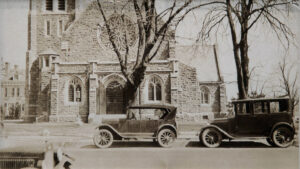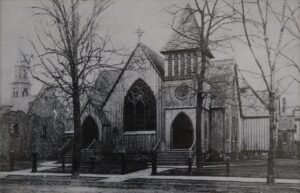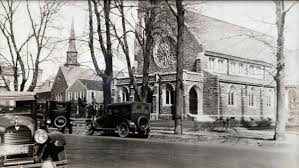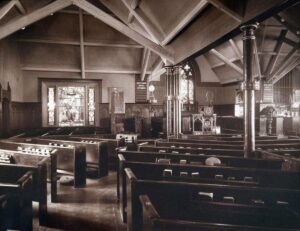A Narrative History of Redeemer

In 1852 The Church of the Redeemer was founded as the second Episcopal Church in Morristown, New Jersey, by a group of people who left St. Peter’s Episcopal Church, nearby in Morristown. We yearned for a different liturgical expression then, and we continue to live that out, today.
The early years of Redeemer focused on growth, in a very low-church style where preaching would have been the most important part of the service.
By the 1920’s a dynamic clergyman was making his mark– Thomas Attridge– and making sure that Morristown had a community center, in the form of the Parish House, with its large parish hall and lower level gymnasium. The youth basketball league would be a fixture for years.
In 1940 the Vestry took a bold step and authorized the use of the church’s meeting space for a little-known organization– Alcoholics Anonymous. It was the first time in the state of New Jersey that an AA group would hold meetings in a church building. It continues to meet at Redeemer to this day.
By the 1970’s the United States was involved in a war in Viet Nam, and at Redeemer the Rector, Sandy Cutler, a conscientious objector who had served time in prison during World War II because of his convictions, was allowing peace activists to meet in church buildings. On the one year anniversary of the ordination of 11 women as priests in Philadelphia, Sandy Cutler sought and received the Vestry’s permission to invite the women to celebrate the Eucharist at Redeemer. It was a significant risk, as the women had been forbidden to exercise their ministry following their ordination.

In 1989 Eric Johnson, the son of lifelong members of the parish, contracted AIDS and came home to live out the last year of his life. The parish realized that AIDS was no longer about “others”; It was about them. Members of the parish began to take AIDS buddy training. This training soon found a home in the parish. The parish then conceived the idea of converting the stone rectory into an AIDS Residence. The Eric Johnson House for people living with AIDS was opened in 1993. An AIDS chapel was created in the church, containing Redeemer’s AIDS quilt.
Under Philip Wilson’s leadership, the vision of liberation and justice began to affect all of Redeemer’s commitments. Members of the parish made a commitment to name and address their own racism, and a Racial Dialogue Group was established. Martin Luther King, Jr. Sunday became a major holy day in the parish. King’s picture and the Black Liberation flag were placed in the nave of the church. Eventually a five-week liturgical Reconciliation Season, built around the songs and images of the Underground Railroad, was created to call the congregation to look at both racism and wider liberation issues.
In 2002 Dr. Sheryl A. Kujawa-Holbrook of the Episcopal Divinity School in Cambridge, Mass., featured Redeemer’s model of diversity as one of six faith communities featured in her book, A House of Prayer for All Peoples.
Committed to ending the language of sexism, the rector and vestry made a commitment to inclusive language in the words and songs used in the liturgy. This meant selecting an inclusive language hymnal and seeking the efforts of talented hymn writers in the congregation to ensure that Redeemer’s music would speak to its vision of liberation.
 Gay, lesbian, bisexual, transgender and queer people were fully welcomed into the parish family. Redeemer performed the first same-sex blessing in 1991. Today at Redeemer, an equal number of same-sex and opposite-sex marriages are performed.
Gay, lesbian, bisexual, transgender and queer people were fully welcomed into the parish family. Redeemer performed the first same-sex blessing in 1991. Today at Redeemer, an equal number of same-sex and opposite-sex marriages are performed.
Worship at Redeemer began to reflect the vision of liberation; new liturgies were crafted. Special Sundays and seasons were created including Recovery Sunday, Holocaust Remembrance Sunday, LGBTQ+ Pride Sunday, Women’s Journeys Sunday, Men’s Journeys Sunday, Transgender Day of Remembrance, Creation Season, Reconciliation Season and the Season of Sacred Story. In order to fully welcome all people at the Eucharist, grape juice was offered along with wine.
When Redeemer called its first woman, and first lesbian rector, the Rev. Dr. Cynthia Black, in 2011, its commitment to radical inclusivity continued. Redeemer became a church known for hosting community events. It has gathered people from the surrounding area in times of national tragedy, such as the Pulse Nightclub massacre, as well as for community-wide celebrations, such as Morristown’s first observance of Juneteenth. Our family grew to include Bethel Church of Morristown, and we continue to worship together at least twice a year. We’ve welcomed the first woman and the first four out lesbian and gay bishops of the Episcopal Church to our pulpit, and haven’t let hate get the last word in Morristown–finding creative ways to turn the destruction of our sign into an opportunity for the community to come together in love, once again. During the COVID-19 Pandemic we pulled together to ensure that the pandemic didn’t get the better of us—mastering Zoom, starting a book group, a pastoral care team, an evening prayer service, a children’s church service and eventually raising necessary funds to install technology in the church to be able to broadcast our services.
Redeemer is committed to radical hospitality, welcoming all people just as they are. At worship on any Sunday, the congregation might include both Christians and non-Christians, believers and agnostics, as well as black, white, gay, straight, and transgender individuals.
Redeemer has been recognized for its model of what it means to be a community of faith. Its vision and purpose are immediately evident to visitors. In 1996, the parish was designated the Church of the Year in the Diocese of Newark, and in 2001 it was listed in Paul Wilkes’ book, Excellent Protestant Congregations, as one of the 300 outstanding Protestant parishes in the nation.

History of the Church of the Redeemer by Year
1852: Group leaves Morristown St. Peter’s to found the Church of the Redeemer. First wardens: William Duer, former president of Columbia College in New York City and Alfred Vail, who worked with Samuel F. B. Morse on the invention of the telegraph.
1853: Parish constructs first Church of the Redeemer, a wood building, at Morris Avenue and Pine Street in Morristown.
1885: 1853 church moved to South Street where Parish Hall now stands.
1917: Second church, large enough to seat 400, constructed of stone near 1853 building. Original church razed in 1920.
1919-1952: With Fr. Thomas Attridge as rector, Redeemer becomes one of the largest parishes in the Diocese of Newark.
1926: Stone parish hall constructed. The parish hall gymnasium becomes a community center.
1935: Stone rectory built at rear of lot on South Street.
1940: First Alcoholics Anonymous (AA) meeting at a New Jersey church held at Redeemer.
1970s: Civil Rights and anti-Vietnam War groups meet at Redeemer.
1974: The Rev. Nancy Wittig of the “Philadelphia Eleven” is the first woman to celebrate the Eucharist at Redeemer, along with The Rev’s Suzanne Hiatt, Jeanette Piccard, Carter Heyward, Merrill Bittner and Allison Cheek.
1987: Phillip Dana Wilson becomes fifteenth rector of Redeemer.
1988: First annual Martin Luther King Jr. Sunday celebrated as a major liberation event at Redeemer.
1990: Creation Season developed at Redeemer. Has since been adopted by other Episcopal churches and dioceses. Vestry and rector make commitment to use inclusive language in all aspects of the larger second service each Sunday.
1991: First Blessing of a same sex union at Redeemer.
1993: Redeemer rectory becomes an AIDS residence. First annual Celebrating Women’s Journeys Sunday on Mother’s Day as a major liberation event at Redeemer. First annual Gay and Lesbian Pride Sunday as a major liberation celebration at Redeemer.
1994: Gay and straight members of Redeemer march in NYC Gay Pride Parade for the first time. First annual Recovery Sunday as a major Redeemer liberation celebration. Grape juice, as well as wine, offered at communion.
1995: Creation of AIDS Chapel and Redeemer AIDS Quilt in the church.
1996: Redeemer designated Diocese of Newark Church of the Year.
2001: Redeemer named one of 300 outstanding Protestant parishes in America in Lilly Endowment study at University of North Carolina.
2003: Redeemer included as a chapter in A House of Prayer for All Peoples by Sheryl A. Kujawa-Holbrook for its program of racial dialogue and healing.
2006: Redeemer becomes an official Peace Site.
2007: Redeemer performs Civil Union of Cindy Meneghin and Maureen Kilian and many others.
2011: Cynthia Black becomes sixteenth rector of Redeemer; we begin “church exchanges” with Bethel A.M.E., worshiping in each others churches for MLK day and the feast of Absalom Jones/Richard Allen. Transgender Day of Remembrance observed for the first time.
2012: Redeemer inaugurates the “Season of Sacred Story” during the time after Pentecost as a way to bring alive scripture and faith stories of lesser-known heroes.
2013: Six month observance of the 150 Anniversary of the Emancipation Proclamation takes place, concluding with Juneteenth party with Bethel A.M.E. on the front lawn.
2014: First RedeemerFest held, incorporating Juneteenth party, and sharing some of our vision and values with the neighborhood– under a big tent on the front lawn.
2015: We welcome the Roman Catholic Womenpriests, who ordain 7 women to the priesthood at Redeemer.
2016: Redeemer Hosts a community-wide vigil following the Pulse Nightclub massacre in Orlando; two weeks later welcome The Rt. Rev. Gene Robinson, the first openly gay bishop in the Episcopal Church as a guest preacher for Pride Sunday.
2017: We rent a bus and go to Washington for the January 21st Women’s March– once again praying with our feet!
2020: Freedom House, an addiction and recovery program, becomes the new occupant of the former rectory on the church campus.
2021: We raise $25,000 to install technology to be able to broadcast our services from the church– making our worship available to all.
2023: An act of vandalism destroys our “All Are Welcome” sign out front. The community comes together in love to say that hate has no home here.
Our Rectors
1852-1857 James H. Tyng
1858-1861 Thomas F. Cornell
1862-1863 John Bolton
1863-1866 John G. Ames
1866-1868 T. G. Clemson
1868-1870 Charles C . Fiske
1870-1872 William Graham Sumner
1872-1880 Samuel Hall
1880-1886 George H. Chadwell
1887-1909 William M. Hughes
1910-1917 Barrett P. Tyler
1919-1952 Thomas W. Attridge
1952-1970 H. Brevoort Cannon
1970-1986 F. Sanford Cutler
1987-2009 Phillip Dana Wilson
2011-Present Cynthia L. Black



